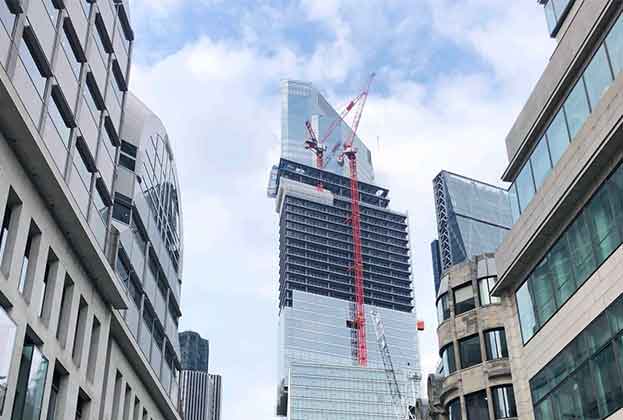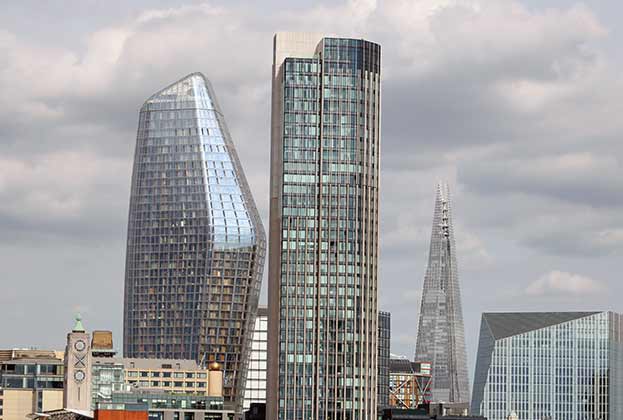Leasing activity remained strong, with occupier demand for best-in-class space continuing to drive transactions despite economic headwinds
Occupational market
During the first half of this year, the Central London occupational market continued to experience strong levels of demand despite the increased uncertainty around the wider economy and rising cost pressures.
At the end of H1, take-up reached 5.2m sq ft, with 3.1m sq ft completed in the second quarter. Overall take-up for H1 was up 13% on the long-term average, with occupier demand for best-in-class space, particularly from larger corporate occupiers, continuing to drive leasing activity. The higher level of demand for best-in-class space is reflected by the fact that 90% of space acquired so far this year has been of Grade A standard, up on a ten-year average of 81%; pre-lets have accounted for a third of this year’s take-up.
There continues to be a clear preference for space with better sustainability credentials, with 53% of take-up being in BREEAM rated Excellent or Outstanding buildings.
Across Central London, there was a more even spread of take-up between the top three sectors with the Insurance & Financial sector accounting for 21%, followed by the Professional Services sector with 19% and Tech & Media with 17%.
In the City, we saw a continuation of the strong demand from Law firms. So far this year, the Professional Services sector has accounted for 29% of space let, with many firms upgrading their current offices for sustainability, brand perception or reasons related to the perceived benefits this new space will have on staff retention. Law firms have accounted for 43% of pre-letting activity in the City this year, the largest being Kirkland & Ellis’ acquisition of the 19th to 34th floors (215,000 sq ft) at 40 Leadenhall, EC3, followed by Hogan Lovells at Royal London Asset Management’s Holborn Viaduct development, EC1 (264,000 sq ft).
The growing preference for fitted space amongst smaller occupiers, which has been driven by cost, convenience and competition from serviced office offerings, has resulted in landlord fitted space accounting for 32% of sub 10,000 sq ft new leases that completed in the City during H1.
In the West End, following five months of subdued leasing activity, a near-record 1.1m sq ft completed in the final month of the quarter. This was the third highest monthly take-up on record for the West End, with June take-up single-handedly accounting for 46% of H1 take-up. Notable transactions to complete included Capital International’s pre-let of the 8th to 16th floors at the Sellar Property Group’s Paddington Square development, W2 (220,000 sq ft), and the long-anticipated completion of MSD’s acquisition of Belgrove House, WC1 (195,000 sq ft), which will form its new UK HQ and Discovery Centre. In total, there were five transactions sized over 50,000 sq ft, which was in line with the pre-Covid long-term average for H1.
The first half of 2022 has performed ahead of the long-term average and demonstrates resilience in Central London’s office market whilst reinforcing the important role that the office plays for businesses. Looking ahead, the clear global and domestic economic and political headwinds may well impact decision-making for businesses, but at the present time, we are encouraged by the depth of demand in the market, particularly for the very best product
Jonathan Gardiner, Head of Central London Office Leasing
In the West End, the Financial Services sector has been a significant source of demand and has accounted for 32% of space acquired so far this year. But focusing more specifically on the sub-sectors driving this activity in the West End, almost 66% of take-up to this sector is made up by acquisitions to Private Equity, Asset Management and Investment Management firms. This continues the trend seen in 2021, where the overall sq ft acquired and the number of transactions to this sub-sector reached a new record at 600,000 sq ft across 64 transactions.
The latest occupancy figures show the West End leading the way in terms of worker return to the office, with peak periods of the week, Tuesday to Thursday, now regularly recording occupancy levels over 40%, and the City following behind with 35%. This is compared to pre-pandemic occupancy levels which varied from 60–70%, varying across industry sectors.
Despite the fact that occupancy levels are reaching over half of what they were prior to the pandemic (assuming a pre-Covid occupancy level of around 65%), leasing activity has continued to remain strong with the impact of new working patterns and hybrid working on the whole not yet appearing to have a significant impact on the quantity of space occupiers are taking.
There continues to be little signs of occupiers changing the size of their requirements despite increasing cost pressures, but this could change in the second half of the year
Our analysis of occupiers who took 15,000 sq ft or more during H1 reveals that 40% of these occupiers were relocating to a similar-sized space in another building, a further 23% were relocating to new buildings and increasing their footprint by more than 20,000 sq ft, and only 11% had downsized.
This activity is broadly consistent with our analysis of current active Central London demand. The majority of occupiers (41%) who are currently actively looking for office space over 10,000 sq ft are seeking to acquire a similar amount of space, and there are more occupiers seeking to increase their footprint (29%) than those seeking to substantially reduce the amount of space they occupy (13%).
Looking forward, we expect full-year take-up to remain in line with the long-term average, reaching around 10m sq ft. Furthermore, with underlying demand continuing to remain high and employment forecasted to grow by 1.8% this year, the outlook looks encouraging. At the end of June, space under offer stood at 2.97m sq ft, which was up 17% on the five-year average, and active requirements stood at 8.85m sq ft, up 5% on the five-year average.
And yet we cannot ignore the expected headwinds for the second half of this year, with inflationary pressures continuing to rise and the Bank of England currently forecasting a UK recession in Q4. This could have an impact of increasing occupier scrutiny on future space commitments and result in more cost-driven decisions being made, for example, occupiers compromising on a larger quantity of space and opting for less space but better quality space or opting for alternative locations versus compromising on quality.
Occupiers continue to want to acquire best-in-class space. This is against a backdrop of rising costs and the increased scrutiny occupiers are under in achieving sustainability accreditations to run their businesses, attract new talent, and win clients. For the majority, environmental considerations remain the most significant part of ESG standards and part of the top criteria utilised by tenants in choosing their offices; alongside location, amenities, natural light, floorplate efficiency, and budget
Paul Bennett, Tenant Representation, Central London Agency
As a result of the concentrated appetite for best-in-class space, alongside the lower levels of supply of this type of stock, we have continued to see average prime rents increase over the year. The average prime rent in the City at the end of H1 stood at £83.72 per sq ft, compared to £80.39 per sq ft at the end of H1 2021. The West End prime rent stood at £119.38 per sq ft, up 2% on the same period a year earlier. We are forecasting average prime rental growth of 3.3% per annum over the next five years as a result of sustained occupier demand for the very best product.
With the flurry of leasing activity and tenant controlled space falling for the seventh quarter in a row, we saw the largest downwards movement to the vacancy rate since Q4 2017. At the end of Q2, the vacancy rate stood at 7.6%, down 50 bps from 8.1% at the end of Q1, with overall supply standing at 19.6m sq ft.
The reduction to tenant controlled space over the quarter was mainly as a result of reductions in the West End, where tenant controlled space is almost at pre-pandemic levels, 1.3m sq ft compared to 1.1m sq ft at the end of Q1 2020. The City, by contrast, has seen tenant controlled space reduce by 10% since its post-pandemic peak level of 3.6m sq ft in October 2021. Although it is worth noting that 43% of City tenant controlled supply (by sq ft) is on a term of five years or less.
We expect the Central London vacancy rate at the end of the year to stay at 8.0%, with 4m sq ft scheduled to complete during the first half of 2023, which will be added to supply by Q4.
Read the other articles within Spotlight: Central London Office Outlook below


